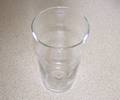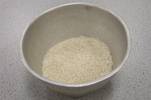Ingredients
| A Bouncy Ball, or Raisins | |
 | 2 empty Pint Glasses |
 | Some dry rice |
 | A Surface to bang a pint glass on, don't use something too hard or you may break the glass! Carpeted floor, or a table with a towel on, is fine. |
Instructions
First, you need to half fill each pint glass with rice, and bury the bouncy ball in the middle of the rice.
Then, gently shake one pint glass up and down without banging it on anything.
Shake the other pint glass by banging it gently on the carpet, or padded surface.
Watch the ball in each glass to see what happens.
Result
You should see:
In the glass you shook in your hand the ball will rise to the top of the rice on one side of the glass, and then sink into the rice again on the other side. If you keep shaking it will loop back around and come to the top again, before sinking back.
In the glass you banged on the surface, the bouncy ball will rise to the top of the rice, and then stay there no matter how much you keep banging the glass.
Explanation
Lets explain the second pint glass first:
As you bang the glass on the surface, the glass, rice and ball all move straight up and down together. As the glass is moving down, the rice spreads out and becomes less dense. This allows gaps to form under the bouncy ball, and the small rice grains fall into these gaps. This means that the bouncy ball is pushed upwards, and will rise to the top of the glass.
In the first pint glass, as you're shaking it in your hand you will shake it at an angle (your arm pivots from the elbow, so you can't help it!) This means that the far side of the glass will be shaken slightly further than the near side. Because of this, the rice gets spread out further on one side than the other, and becomes less dense. Just like in a liquid, material that is less dense rises above that which is more dense. This means the ball gets pulled to the top with the less dense rice.
However, once it gets to the top the rice moves towards the middle, where it is shaken less and therefore becomes more dense. This means that the rice then sinks again on the near side, and pulls the ball back down with it.
This circulation of material is called a convection current, and is the same method by which a radiator heats your entire room - the less dense air (warmer air) rises above the heater, but then as it moves across the ceiling it cools, becomes more dense and falls back down. This sets up a convection current - a circulation which pulls warmer air around the room.
[pictures to follow]
- Previous Floating a Needle
- Next Cup Fountain










Comments
Add a comment